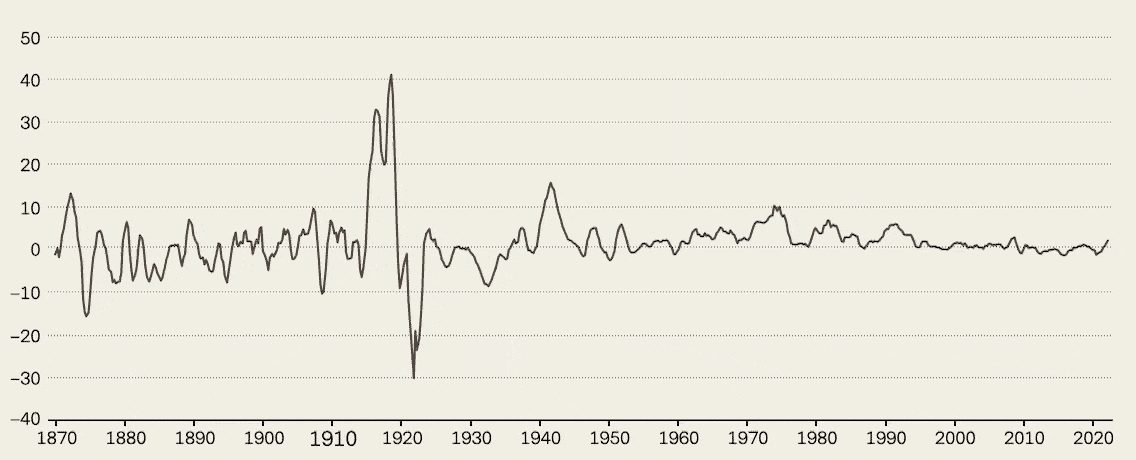
Inflation: Enemy of the state or debt policy pet?
Pubblicato il 25.04.2022 CEST
Until recently, inflation was an (almost) forgotten specter of the past. Nowadays, one inflation catchline is followed closely by the next – and not only in the economic press. In this article, three economists expose and debunk the fears that lie at the heart of the subject.
Find out more about what exactly inflation is, how it arises and the three most common types of inflation.
Inflation as political ballgame
Russian revolutionary Vladimir Lenin dubbed it a way to “crush the bourgeoisie”. Gerald Ford, the 38th president of the United States, declared it “enemy of the state”. Ronald Reagan described it as “as violent as a mugger, as frightening as an armed robber and as deadly as a hit man”.
If leading statesmen need to resort to metaphors which conjure up images of armed conflict in order to make inflation comprehensible what actually is the cause of this inflation angst – this reflex reaction which many of us have when faced with the subject?
At a time when the subject is the focus of the world’s economies and politicians – from left to right and everything in between – is it worth taking a good look at the sobering facts.
BRIEF DEFINITION
What is inflation?
The term “inflation” describes a general increase in the prices of goods and services in an economy. This “general increase” for a variety of goods and services is important – inflation does not arise due to one item becoming more expensive, it only occurs when there is a broad-based increase of prices. Over time, this price increase results in a decline of the purchasing power of a given currency in an economy.
Imported inflation
In this respect, inflation can not only have implications for a country’s domestic currency. It can also affect the country’s foreign exchange rate with other countries and have consequences for trading goods and services. This is because the more a country’s currency depreciates on the foreign exchange market, the higher the price of imports it must pay. Thus, imported raw materials or energy impact a country’s domestic costs of production.
What are the main causes of inflation?
The fact that prices were going to rise in 2021 was not a surprise for most analysts. So-called baseline effects, supply-chain bottlenecks and the strong economic upswing following the pandemic all indicated that it was only a matter of time before a certain level of inflation would take hold.
We define the main reasons for inflation factors according to the time horizons of their impact. In our analyses, therefore, we distinguish between short, medium and long-term factors.
Three factors which drive prices higher
We define “short-term” inflation as being up to one year.
One important short-term driver comes in the form of supply shortages, as seen during the pandemic. Especially car manufacturers can tell us a thing or two about this, as many of them had difficulty getting their hands on semiconductor chips and other car components after Covid-19 curtailed production at various Asian factories.
Apart from that, a sudden increase in demand can result in higher prices, as well. This could be witnessed during the reopening of the economy after the lockdowns.
Other short-term drivers may occur due to weather conditions. Take last year’s frost in Brazil, which drove up prices for sugar and coffee futures, droughts which might wipe out farmers’ harvest, or a harsher-than-expected winter which results in increased demand for heating oil.
The – at times – significant volatility of food and energy products is also why economists like to differentiate between so-called “headline” and “core” inflation”. * Headline inflation can be viewed as a measure of total inflation, as it includes expenditures for volatile items such as food and energy. Core inflation, on the other hand, omits these components, and is viewed as an indicator of underlying long-term inflation.
Lastly, there are also seasonal factors (Christmas season, for example), or extraordinary events such as accidents which occur during the production or transportation process.
* Countries have different approaches when it comes to core inflation. While some countries differentiate only between “headline” versus “core”, others pursue an even more granular approach. Japan, for example, differentiates between “headline”, “core” (excl. fresh food, but incl. energy), and “core-core” (excl. fresh food & excl. energy).
We define medium-term drivers as typically lasting from around one to two years. They are not necessarily structural but have the potential to become structural.
The most important one comes in the form of expansionary monetary policy. When “more money is chasing the same number of goods”, i.e., when the money supply in an economy grows faster than the economy’s ability to produce goods and services, prices should go up.*
“The proposition that higher money supply leads to inflation is for sure one of the oldest and most enduring concepts in economics”.
Higher money supply = rising prices?
There are cases which support this theory:
- One of the oldest being the US Civil War (1861–1865). As Confederate leaders were unwilling to finance the war via higher taxes out of fear that it would undermine public support for their cause, they sought to meet most of their expenses by “printing” money. The issue of substantial amounts of Treasury notes ultimately drove up prices in the Confederacy by more than 9,000 percent (versus “only” 80 percent in the North).
However, some argue that the proposition does not always hold:
- In the aftermath of the global financial crisis, for example, central banks flooded the markets with monetary stimulus and continued to do so for more than a decade without this having a significant effect on consumer prices.
- An even more compelling case can be observed in Japan. There, prices refuse to rise despite decades of ultra-loose monetary policy.
In conclusion, we consider increased money supply growth as a necessary factor for more inflation, but it is also a factor that does not lead to more inflation by itself.
“Whoever is expecting higher prices has an incentive to invest now, not later”.
Another medium-term driver, ironically, comes in the form of inflation itself – or, in other words, inflation expectations. Inflation expectations reflect the rate at which parties (consumers, businesses, or investors) believe prices will rise going forward. The underlying rationale is that: whoever is expecting higher prices has an incentive to invest now, not later.
This could, in turn, drive inflation higher.
*How is money supply measured? Various metrics exist, with the most prominent ones being M0, M1, and M2 and M3. M0 refers to all the physical money in circulation, M1 includes M0 and adds also sight and overnight deposits and checking accounts, i.e., money that is immediately available (so-called “narrow money”). M2 adds to M1 also easily convertible money, such as savings deposits or time deposits that are typically redeemable at notice up to three months. M3, on the other hand, is also referred to as “broad money”, and incorporates M2 as well as large time deposits in banks and marketable securities with a maturity of no longer than two years.
We define “long-term” as lasting for two or more years.
Long-term drivers are more on the structural side for example, demographic developments, such as an ageing population. Another one comes in the form of growing de-globalization and long-term polarization around the globe – just think of supply chain shifts from developing countries towards developed countries.
Then there’s also climate change. A higher occurrence of natural disasters will lead to fluctuations in output which will act as inflation drivers – as was the case following the recent lockdowns.
It is believed that the shift towards a “greener” future will push prices higher. Measures such as phasing out coal and oil, or insulating buildings. This has been designated as “greenflation”. In this context, we may not forget policies to mitigate climate change, such as carbon pricing programs.
Inflationary shocks in context: USA vs. Switzerland from 1870 to 2022
At 8.54%, the inflation figures for March 2022, published in April, are significantly higher in the U.S. than the 2.4% reported for Switzerland. However, this was not always the case, as a historical look at the last 150 years shows. The following chart is based on Consumer Price Index data (CPI). The figures for Switzerland before 1922 are based on estimates by researchers.
Before World War II, inflationary shocks in Switzerland were higher than in the U.S.

▬ Inflation rates in the USA 2022 back to 1870 (in %)
▬ Inflation rates in Switzerland 2022 back to 1870 (in %)
© Vontobel 2022, based on research by Niko Hauzenberger, Daniel Kaufmann, Rebecca Stuart, Cédric Tille: “Interest rates in Switzerland 1852–2020”, Fundamentals for Economic Policy No. 24, State Secretariat for Economic Affairs SECO, Bern, Switzerland (2021), as well as on data of the Federal Statistical Office (FSO), Global Financial Data, Refinitiv Datastream.
Demand-pull inflation
This occurs when the demand in an economy outpaces the supply, thereby pulling up prices. But just exactly how can demand overtake supply?
Such a scenario can, for example, unfold in a booming economy.
When households feel confident about the economic prospects, they are inclined to spend more than if they believe that tougher times are ahead. Some also argue that governmental actions can drive prices higher. Tax cuts, for example, increase consumers’ disposable income. This enables them to spend more money and should ultimately result in higher inflation.
Many economists also believe that stimulus checks, such as those handed out in the aftermath of the pandemic, have resulted in “too much money chasing too few goods”, therefore driving prices higher.
Cost-push inflation
This arises when demand remains the same while the supply of goods or services is limited, thereby pushing up prices.
This can, for example, be the case when there is a significant shortage in raw materials or in labor.
This type of inflation is often accompanied by some sort of external event, or by a lack of investment that can lead to undersupply later.
One historical cost-push inflation event occurred in the 1970s, when the Organization of Arab Petroleum Exporting Countries (OAPEC) imposed an oil embargo against the United States.
- The implemented cuts saw the oil price nearly quadruple from 2.90 US-dollars a barrel (before the embargo) to 11.65 US-dollars a barrel (in January 1974).
- As petrol prices became more expensive, so did transport. This forced many manufacturing firms to scale back production, as they could not afford to pay the higher fuel and transport costs.*
* The foundation for the high inflation of the 1970s was laid long before the turmoil on the oil markets. In the 1960s, for example, expenses related to the cold war, space programs, and other factors already strained the US national budget.
Covid-19 has provided us with many examples for Cost-push inflation. Just think of higher-than-expected shipping costs, with freight rates about five times their average over the past decade, or temporary factory shutdowns:
- In Vietnam, factory lockdowns have significantly impacted apparel and footwear retailers such as Nike or Under Armour.
- Shutdown of several semiconductor plants in Malaysia, which plays a little-known, but important role in the global chip manufacturing process, had a significant impact on global chip production. According to the Malaysian Investment Development Authority, approximately seven percent of the total global semiconductor trade passes through the country.
In 2019, for example, the African Swine Fever forced China to cull more than a million pigs. The resulting pork shortage sent pork prices up 110 percent year-on-year in November 2019, pushing Chinese inflation to an eight-year high.
Stagflation
When everything bad comes together
The term “stagflation” describes a situation that is characterized by four factors: rising prices, stagnating economic growth, disappointing corporate earnings, and high unemployment.
While economists disagree on the causes of stagflation, arguments such as poor economic policies and supply shocks are cited the most often.
Poor economic policies can come in the form of business-unfriendly policies or high taxes, typically accompanied by money supply that is growing too quickly. In the US, for example, the economic boom years of the late 1950s and 1960s paved the way for the 1970s stagflation.
Supply shocks, on the other hand, can arise if an economy is witnessing a sudden in- or decrease in the supply of a commodity or service. Examples include energy, food, or labor supply shocks, as, for example, during the Weimar Republic.
Talking about supply shocks: especially the current situation has stoked fears that we might soon enter a stagflation period. While we cannot rule out such a scenario, we currently do not deem it likely.
True, economic growth has indeed lost some steam when compared to the strong bounce back in the immediate aftermath of the pandemic. However, we think it is important to bear in mind that growth has come down from very high levels and remains higher than pre-Covid-19.
On top of that, unemployment rates are declining in many parts of the world while corporate earnings remain solid – the latter was once more confirmed by the Q3 2021 reporting season, which showed that companies continued to surprise to the upside despite rising price pressure.
Lastly, households’ finances remain robust, suggesting potential for more spending further down the road.
Figure: Household savings rates in % of personal income
| ▬ USA | ▬ Switzerland | |
| ▬ UK | ▬ Japan | |
| ▬ China | ▬ Euro zone |
© Vontobel 2022. Source: Refinitiv Datastream, Oxford Economics, Vontobel
Savings rates remain well above pre-Covid-19 levels in many places around the world.
Winners and losers in an inflationary environment
Who suffers the most when prices are rising? First and foremost, the savers – because higher prices lower the real value of their savings.
Employees who are tied to fixed-wage contracts are also impacted, as are credit allocators such as banks who have fixed interest-rate returns on the money they have loaned. Then there are the importers whose goods typically become more expensive when their domestic currency loses value against currencies with lower rates of inflation.
Others, though, profit from higher prices: as a rule, anyone with debts at a nominal fixed interest rate, such as indebted governments, companies and private households.
Companies with high levels of debt typically also benefit. Often, an inflationary environment makes it possible for them to pass on higher production prices to consumers. The “additional money” which is generated can be used to service existing debt.
In addition, private individuals who have invested in so-called inflation hedging (material assets such as real estate, commodities or gold) also benefit when the value of their investments increases.
Worth reading in this context
Pubblicato il 25.04.2022 CEST
SULL'AUTORE
 Mostra altri articoli
Mostra altri articoliStefan Eppenberger
Head Investment Strategy
Stefan Eppenberger è entrato in Vontobel nel 2008. Dal settembre 2024, è Chief Investment Strategist all'interno di Multi Asset e guida l’Investment Strategy Team. È responsabile di definire la strategia di investimento applicata ai portafogli clienti. Inoltre, è membro votante del Multi Asset Investment Committee. In precedenza, ha ricoperto diverse posizioni in materia di analisi economica, strategia d'investimento, asset allocation, ricerca su fondi e gestione di portafoglio.

